
A business line is like a bustling kitchen, where operational work is the daily stuff that keeps the operation running, like washing dishes, sweeping the floor and straightening the tables, while capital projects are the bold, one-off recipes—think a gourmet dish with a set budget, timeline, and a specific wow factor.
The way you organize your kitchen crew can make or break the meal! The bad news is that you can create a bad taste in customers’ mouths with a poorly thought out plan. The good news is that you have plenty of control over the process that creates the result.
There are four types of organizational structures, each of which has their own unique set of influences on the management of the organization’s projects:
- Functional
- Project
- Matrix
- Composite
Get ready to explore these structures and discover which one will turn your project kitchen into a Michelin-star operation!
Functional
Most organizations are divided along functional lines, that is, each “division” is organized by work type, such as engineering, production, or sales.
In the functional organizational structure, projects are initiated and executed by the divisional managers, who assume the project manager duties in addition to their regular, functional, roles. They are often given secondary titles such as “Coordinator of Project X.”
In this structure, project managers usually don’t have alot of authority to obtain resources or to manage schedules and budgets. They must obtain approvals to utilize resources from other departments, which can be a complex undertaking. This is because the functional organization is designed to focus on the provision of the divisional services rather than project deliverables.
Project-Oriented
On the other end of the scale is the project-oriented organization. These companies do most of their work on a project basis and are therefore structured around projects. This includes contractors, consultants, and service firms.
Project managers are usually full time in the role, and for small projects they might manage several projects at once.
In this structure project managers usually have a great deal of independence and authority. They are able to draw on resources with little required approval.
In fact, most of these types of organizations have some form of functional divisions which are placeholders for resources that can be utilized by all projects. They are usually called “departments.”
For example, at an engineering firm the geotechnical department is available as an expert resource to all projects within the firm.
Matrix
Although the project-oriented and functional structures are at opposite ends of the spectrum, it is possible to be located somewhere in between (a hybrid). In fact, most organizations are along some level of the spectrum, utilizing a structure that gives project managers a bit more authority without losing focus on the provision of functional services.
In the typical matrix structure, a project manager is assigned from within one of the functional departments in either a part time or full time capacity. They are assigned project team members from various departments, who are released from their departmental duties (at least partially). Thus, a high priority can be placed on the project while maintaining the functional division services.
However, the project manager and team members are still paid by their respective functional departments, thus the final accountability for the project still lies at the functional level. For example, if one of the department managers thinks that they have contributed more than their fair share, the project will likely stall quickly.
From a theoretical point of view, there are two more adjustments that can be made. A weak matrix retains the management of the project in the hands of the functional managers instead of the project team, like this:
On the other side, a strong matrix is still a functional organizational structure, but has a completely separate project management arm. All of the project roles are still fulfilled within the functional departments, but the project manager is on the same level as the functional managers.
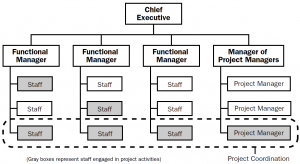 This project management arm often takes the form of a Project Management Office, or PMO.
This project management arm often takes the form of a Project Management Office, or PMO.
In spite of its name, the terms strong and weak matrix are not meant to imply a level of desirability to the organization. The names have been coined by the project management industry which has studied the role of projects within organizations, and hence they correspond to strength or weakness in achieving project success. But if that comes at the expense of poorer delivery of functional services, the organizational’s goals are not necessarily being achieved. Hence, the correct project organizational structure is one which achieves the organization’s goals, and this can fall anywhere along the project/functional spectrum according to the specific needs of the organization and/or project.
Composite
Functional organizations and project-oriented organizations are at opposite ends of the spectrum and matrix organizations fall somewhere in between. But it is possible to utilize both structures at the same time. Therefore, there is a fourth option that requires mention, the composite structure.
This occurs when a project structure and a functional structure both report to a central executive.
For example, a state government department of transportation has a Maintenance division which seeks to maintain the level of service of the state’s roads and bridges, and a Capital Projects division which builds new roads and bridges. The maintenance division and the capital projects division are located side by side, reporting to the executive. This is a composite organizational structure (For reference, a matrix structure would require new construction to occur within one of the maintenance departments – the project manager would report to a functional manager rather than the executive).
Most organizations lean one way or the other rather than using both structures, because of the drastically different management styles necessary to perform each of the roles well.
Examples
- A car dealership wants to initiate a new sales process. It assigns the design and implementation to the sales manager, who utilizes some of the sales as well as maintenance personnel to develop the necessary documents and implement the plan. This is a functional organizational structure.
- A web design firm has a user interface design department, which is available for project work when necessary. The UI department supports the firm’s projects and doesn’t otherwise carry out much work on its own. This is a project-oriented organizational structure.
- A vehicle manufacturing firm sets up a project to modernize its assembly line whereby the project manager is dedicated full time to the project and reports to the executive. The project manager chooses their project team from the design, production, and maintenance departments, who must balance their time between their regular duties and achieving their project work. This is a strong matrix organization.





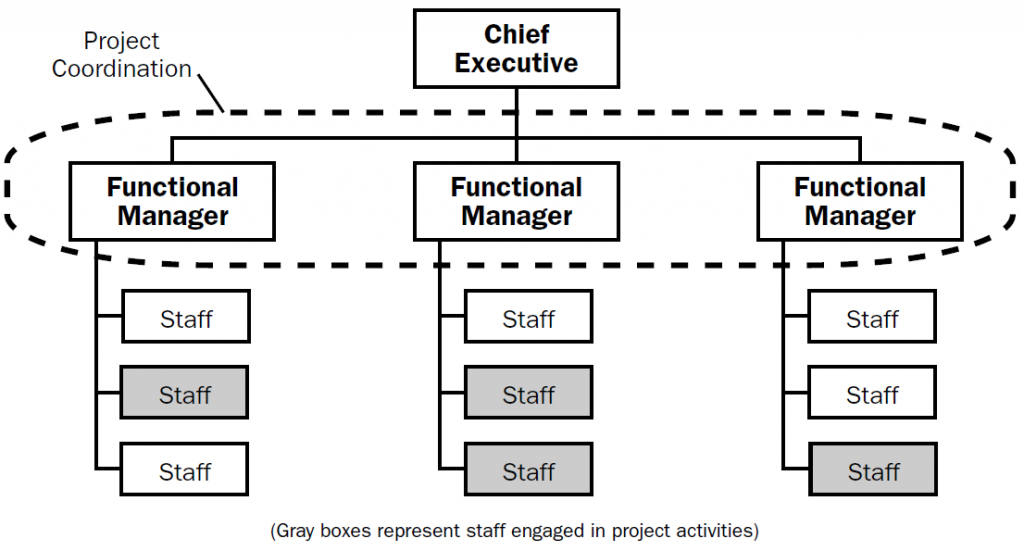
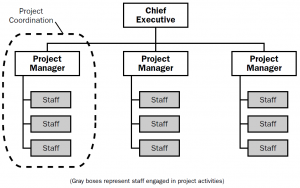
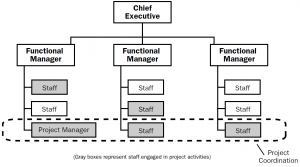
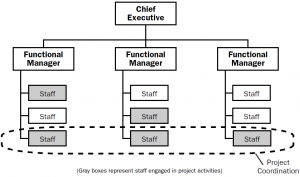
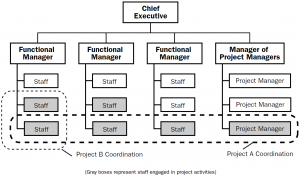


Leave a Reply